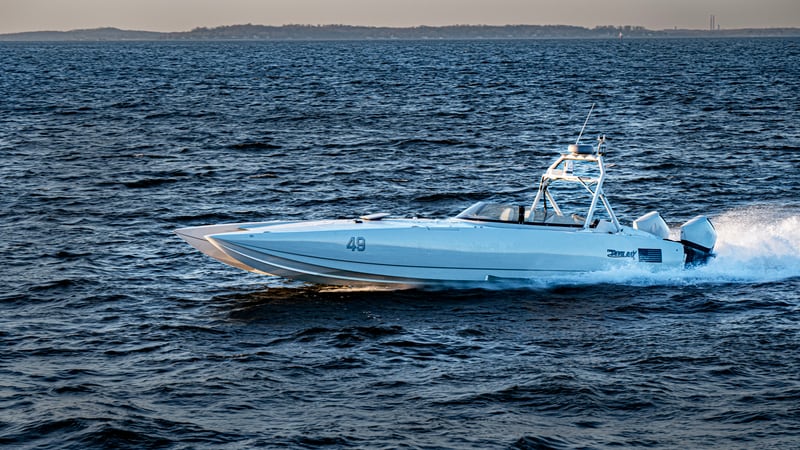SAN DIEGO — The chief of naval operations is bullish on the Navy’s ability to operate a manned-unmanned fleet within the next decade or so, thanks to the prototyping and learning happening today.
“The promise of unmanned is actually here,” as the Navy today experiments with unmanned systems in U.S. 5th Fleet in the Middle East, U.S. 4th Fleet in Central and South America, and U.S. 7th Fleet in the Pacific, Adm. Lisa Franchetti said Tuesday at the WEST 2024 conference in San Diego.
RELATED

She said the Navy is focused on the eventual incorporation of unmanned systems into real-world operations, even if they largely exist today as one-off prototypes.
Defense News reported last year that the Navy viewed its manned-unmanned hybrid fleet in three phases: prototyping and experimentation in the five-year Future Years Defense Program, from fiscal 2024 through 2028; buying programs of record and beginning to use them in the next FYDP, from FY29-33; and having a fully operational unmanned fleet in the third FYDP.
Franchetti told attendees at the conference hosted by the U.S. Naval Institute and AFCEA that she stands by that timeline and that the Navy would be operating unmanned systems “at speed and scale” in real-world missions by that third FYDP.
In addition to the experimentation the U.S. Navy is undertaking today, the CNO said the service is focused on creating the infrastructure, networks, concepts of operations and other enablers of future unmanned operations.
Franchetti said many of her foreign counterparts are also eyeing unmanned systems for warfighting or for maritime surveillance, creating an opportunity to learn together and partner as the technology matures.
She also noted the U.S. Navy already has the MQ-4C Triton flying today out of Guam, with the next detachment standing up “soon” in at Naval Air Station Sigonella in Italy, and another detachment out of Bahrain to follow.
The CNO added the Navy is still on track to hit initial operational capability for its MQ-25 Stingray carrier-based unmanned refueling aircraft in 2026, which will add range and lethality to the carrier air wing.
‘Not about numbers’
Franchetti addressed ongoing concerns and criticisms that the Navy’s manned fleet is too small, sitting at 292 compared to a requirement for more than 380.
“It’s clear that we do need a larger navy,” she noted, adding that every Navy study supports that notion. But she added, “I look at our navy as part of a broader warfighting ecosystem. It’s not about numbers; it’s about how you put it all together. It’s platforms on, under and above the sea; it’s the networks that enable them; it’s the cyber; it’s our work in space; it’s work with all the joint force.”
With this all, coupled with the Navy’s incorporation of emerging technologies, “we are the dominant combat warfighting force,” she concluded.
Franchetti addressed four key technology focus areas during her prepared remarks.
First, she said, the fleet is using artificial intelligence and machine learning to allow for condition-based maintenance that frees up sailors to do more important work to keep their ships ready to fight; it’s using additive manufacturing on large ships like aircraft carriers and amphibious assault ships to keep the ships ready; and it’s using robotics to assess the material condition of ships.
Second, she said the drive to incorporate unmanned systems will increase the range and lethality of the manned fleet.
Third, she said the Project Overmatch fleetwide connectivity effort will support distributed maritime operations and decision superiority, allowing data to flow reliably when needed.
And lastly, she said, the Navy is focused on getting its people ready to use these technologies. In addition to creating more training opportunities and empowering junior sailors who are proficient in using unmanned systems, big data, additive manufacturing and other highly sought-after skills, she said the service is also exploring the establishment of a robotics rating to create a cadre of experts to manage the future manned-unmanned fleet.
Megan Eckstein is the naval warfare reporter at Defense News. She has covered military news since 2009, with a focus on U.S. Navy and Marine Corps operations, acquisition programs and budgets. She has reported from four geographic fleets and is happiest when she’s filing stories from a ship. Megan is a University of Maryland alumna.
- SEO Powered Content & PR Distribution. Get Amplified Today.
- PlatoData.Network Vertical Generative Ai. Empower Yourself. Access Here.
- PlatoAiStream. Web3 Intelligence. Knowledge Amplified. Access Here.
- PlatoESG. Carbon, CleanTech, Energy, Environment, Solar, Waste Management. Access Here.
- PlatoHealth. Biotech and Clinical Trials Intelligence. Access Here.
- Source: https://www.defensenews.com/naval/2024/02/13/franchetti-confident-prototypes-will-usher-in-manned-unmanned-fleet/



